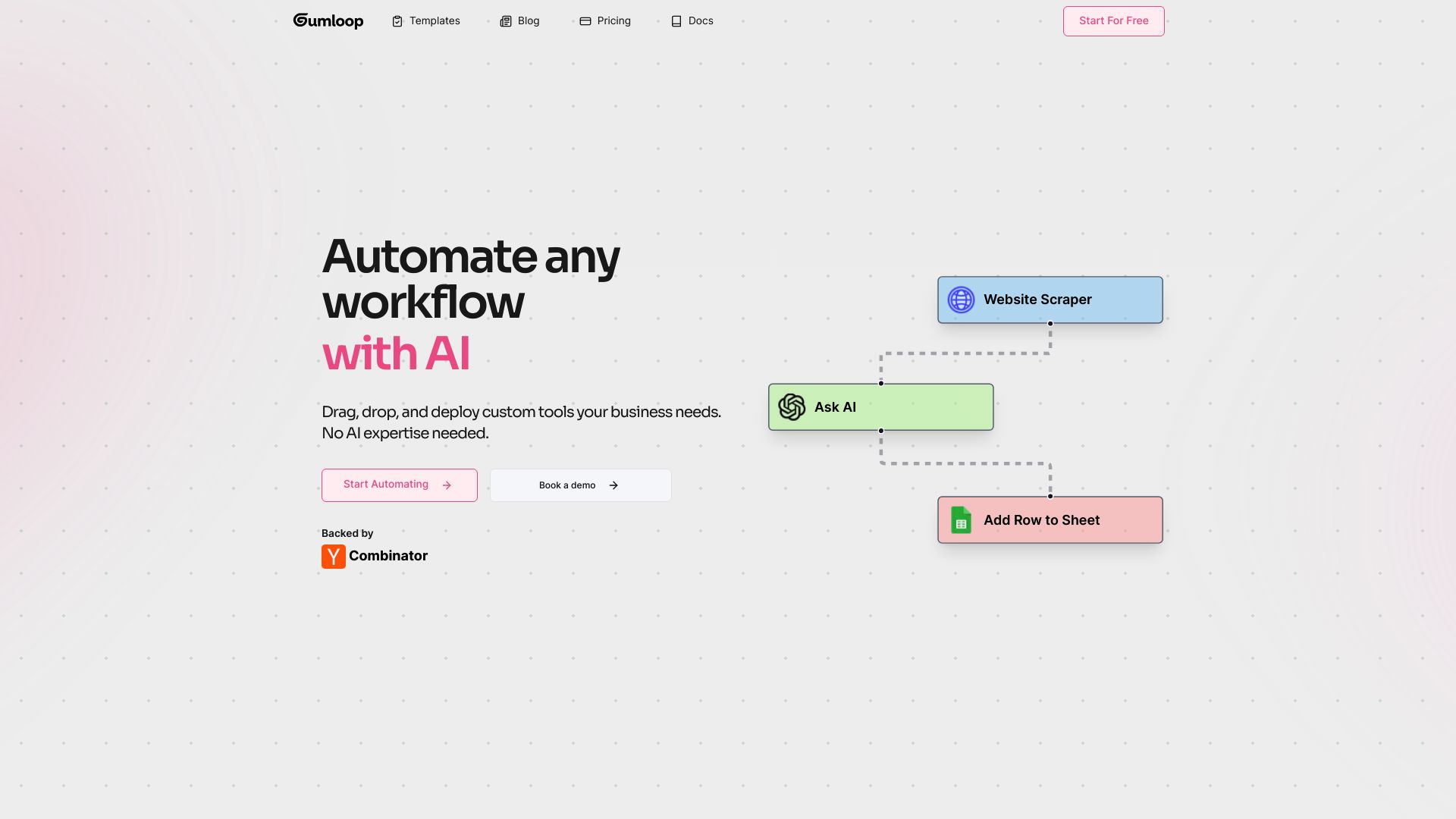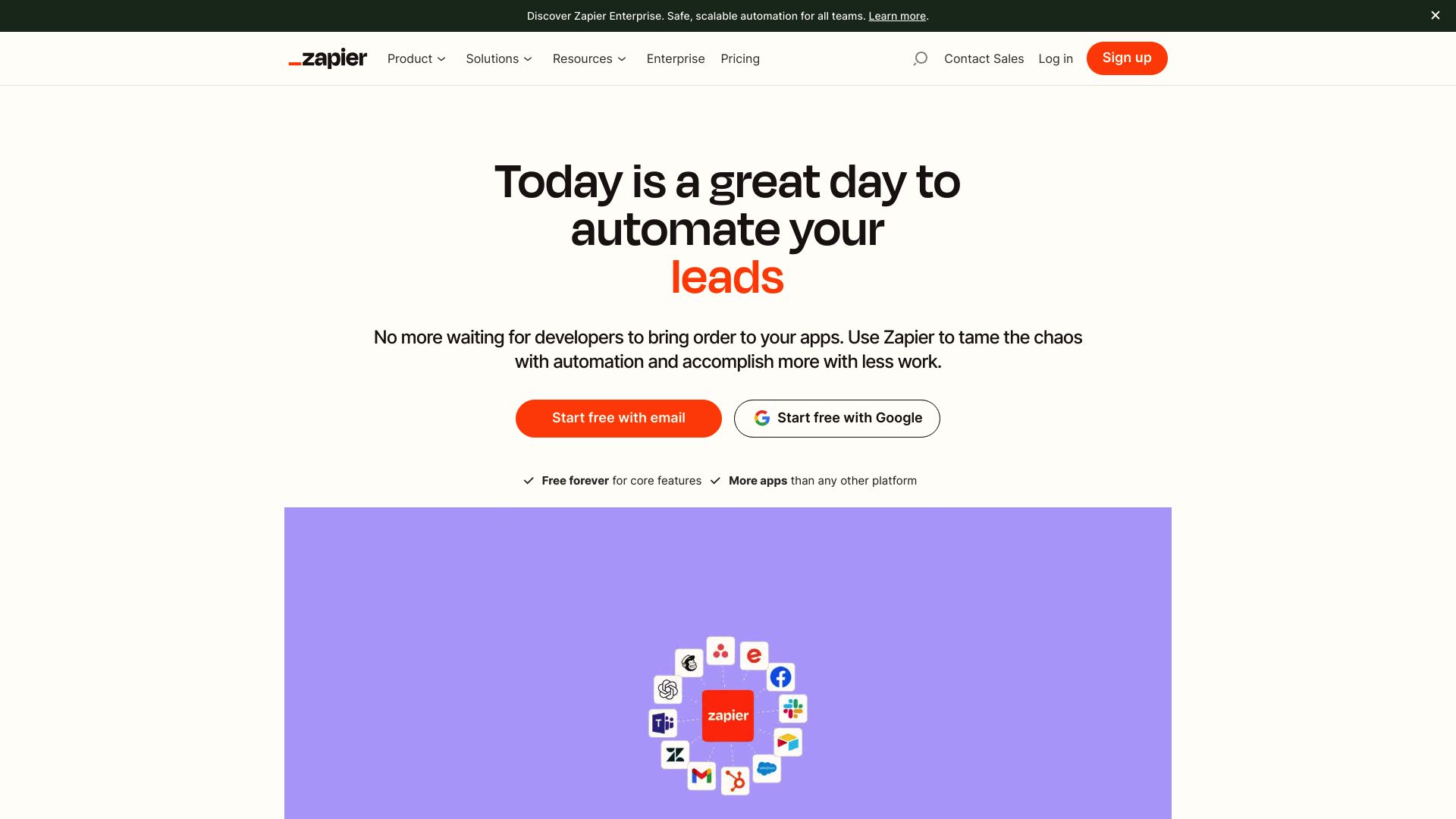AgentHub vs. Zapier: AI Automation vs. App Integration
AI automation platforms revolutionize business operations, offering powerful tools to streamline workflows and boost productivity. This comparison explores AgentHub’s AI-driven approach, Zapier’s extensive app integrations, and SmythOS’s comprehensive solution. We examine each platform’s strengths in workflow creation, integration capabilities, and AI functionalities.
Whether you’re a developer seeking advanced AI tools, a business leader focused on scalability, or a non-technical user looking for accessibility, this review provides insights to help you choose the right platform for your automation needs. Discover how these tools stack up in features, ease of use, and potential to transform your business processes.
AgentHub Overview
AgentHub transforms AI automation for businesses through its no-code platform. The visual builder empowers users to create AI-powered workflows without coding expertise, democratizing access to advanced AI capabilities.
The platform excels in lead generation, client management, and marketing automation for industries like real estate. Its drag-and-drop interface allows quick development of customized AI agents for tasks ranging from social media management to transaction processing.
AgentHub transforms AI automation for businesses through its no-code platform. The visual builder empowers users to create AI-powered workflows without coding expertise…


AgentHub offers pre-optimized agents for specific tasks, eliminating the need for prompt engineering. Users can tailor workflows using various nodes and seamlessly integrate with multiple platforms. This flexibility makes AgentHub suitable for businesses seeking to enhance operational efficiency across sales, CRM, web scraping, and software development domains.
The platform supports both development and production environments, facilitating smooth transitions from testing to deployment. AgentHub’s agents utilize memory and context for improved task accuracy, and the system enables multi-agent collaboration for complex problem-solving. Comprehensive logs and monitoring tools provide insights into agent performance, allowing for continuous optimization.
AgentHub’s agents utilize memory and context for improved task accuracy, and the system enables multi-agent collaboration for complex problem-solving.
While AgentHub offers robust features, it lacks some advanced capabilities like constrained alignment and a hosted vector database. However, its focus on user-friendly design and integration with common business applications makes it an attractive option for organizations looking to leverage AI without extensive technical resources.
Zapier Overview
Zapier connects over 6,000 web apps and services, enabling users to create automated workflows without coding. The platform’s visual builder and pre-built integrations simplify the process of linking disparate tools and automating repetitive tasks.


Zapier’s strength lies in its extensive library of app integrations and user-friendly interface. Users can create “Zaps” — automated workflows that trigger actions in one app based on events in another. This functionality proves invaluable for businesses looking to streamline operations, improve productivity, and reduce manual data entry.
Zapier’s strength lies in its extensive library of app integrations and user-friendly interface. Users can create “Zaps” — automated workflows that trigger actions in one app based on events in another.
While Zapier excels at integrations, it lacks some advanced AI capabilities found in dedicated agent builders. The platform doesn’t offer tools for building conversational AI or natural language processing systems. Instead, it focuses on connecting existing services and automating workflows between them.
Zapier’s pricing model scales with usage, which can become costly for high-volume users or large enterprises. However, its robust feature set and wide range of integrations often justify the investment for businesses seeking to automate their processes across multiple platforms.
Feature Comparison
AgentHub and Zapier offer distinct approaches to workflow automation, with AgentHub focusing on AI-powered agents and Zapier excelling in app integrations. AgentHub provides a visual builder for creating AI workflows without coding, while Zapier connects existing web services through its extensive app library. AgentHub’s strength lies in its AI capabilities, offering features like memory and context for improved task accuracy, multi-agent collaboration, and problem-solving abilities. Zapier, however, lacks advanced AI functionalities, instead prioritizing its vast ecosystem of app integrations.
In terms of core components, AgentHub offers more robust AI-centric features. It supports autonomous agents, debug modes, and multimodal interactions, which are not primary focuses for Zapier. AgentHub also provides more advanced problem-solving capabilities through its AI agents, whereas Zapier’s automation is primarily based on predefined triggers and actions between integrated apps.
Regarding security, both platforms offer data encryption and OAuth authentication. However, AgentHub lacks some advanced security features like constrained alignment and IP control, which may be crucial for certain enterprise deployments. Zapier’s long-standing presence in the market may give it an edge in terms of established security practices and compliance standards.
Feature Comparison Table
| AgentHub | Zapier | SmythOS | |
|---|---|---|---|
| CORE FEATURES | |||
| AI Agents | ✅ | ❌ | ✅ |
| Hosted Agents (Dev, Production) | ✅ | ❌ | ✅ |
| Memory & Context | ✅ | ❌ | ✅ |
| Autonomous Agents | ✅ | ❌ | ✅ |
| Explainability & Transparency | ✅ | ❌ | ✅ |
| Multimodal | ❌ | ❌ | ✅ |
| Problem-Solving Capabilities | ✅ | ❌ | ✅ |
| Multi-Agent Collaboration | ✅ | ❌ | ✅ |
| Human-AI Interaction | ✅ | ❌ | ✅ |
| Agent Work Scheduler | ✅ | ❌ | ✅ |
| SECURITY | |||
| Constrained Alignment | ❌ | ❌ | ✅ |
| Data Encryption | ❌ | ✅ | ✅ |
| OAuth | ❌ | ✅ | ✅ |
| IP Control | ❌ | ❌ | ✅ |
| COMPONENTS | |||
| Foundation AIs | ✅ | ❌ | ✅ |
| Huggingface AIs | ❌ | ❌ | ✅ |
| Zapier APIs | ❌ | ✅ | ✅ |
| Classifiers | ❌ | ❌ | ✅ |
| Logic | ✅ | ❌ | ✅ |
| Data Lakes | ❌ | ❌ | ✅ |
| DEPLOYMENT OPTIONS (EMBODIMENTS) | |||
| Staging Domains | ❌ | ✅ | ✅ |
| Production Domains | ❌ | ✅ | ✅ |
| API Authentication (OAuth + Key) | ❌ | ✅ | ✅ |
| Deploy as Site Chat | ❌ | ❌ | ✅ |
| Deploy as Scheduled Agent | ✅ | ❌ | ✅ |
| Deploy as GPT | ❌ | ❌ | ✅ |
| DATA LAKE SUPPORT | |||
| Hosted Vector Database | ❌ | ❌ | ✅ |
| Sitemap Crawler | ❌ | ❌ | ✅ |
| YouTube Transcript Crawler | ❌ | ❌ | ✅ |
| URL Crawler | ✅ | ❌ | ✅ |
| PDF Support | ❌ | ❌ | ✅ |
| Word File Support | ❌ | ❌ | ✅ |
| TXT File Support | ❌ | ❌ | ✅ |
Best Alternative to AgentHub and Zapier
SmythOS stands out as the superior alternative to AgentHub and Zapier for AI automation and workflow integration. Our platform combines the best of both worlds, offering advanced AI agent capabilities and extensive app integrations in one powerful solution.
Unlike AgentHub’s limited AI focus or Zapier’s lack of AI features, SmythOS provides a comprehensive suite of AI tools. We enable users to create sophisticated AI agents using our intuitive drag-and-drop interface, no coding required. These agents can handle complex tasks autonomously, from natural language processing to multi-step problem solving.
SmythOS provides a comprehensive suite of AI tools… users can create sophisticated AI agents using our intuitive drag-and-drop interface, no coding required.
While Zapier excels at connecting apps, it falls short in AI capabilities. SmythOS bridges this gap by offering both extensive integrations and cutting-edge AI. We support connections to thousands of apps and services, including popular platforms like Slack, Trello, and Google Workspace. This allows users to create AI-powered workflows that seamlessly integrate with their existing tools.
SmythOS also addresses key limitations of both competitors. Unlike AgentHub, we provide robust security features like data encryption and OAuth authentication. And unlike Zapier, we offer advanced AI components like foundation models, classifiers, and hosted vector databases. Our platform is built for scalability, supporting everything from simple automations to enterprise-grade AI deployments.
With SmythOS, the possibilities are truly limitless. Whether you need intelligent chatbots, automated data analysis, or complex multi-agent systems, our platform provides the tools to bring your ideas to life. We empower users of all skill levels to harness the full potential of AI and workflow automation in one unified solution.
Conclusion
AgentHub and Zapier offer distinct approaches to workflow automation, each with its own strengths. AgentHub excels in AI-powered automation, providing a visual builder for creating sophisticated workflows without coding. Its AI agents leverage memory and context for improved accuracy, making it ideal for businesses seeking advanced automation in areas like lead generation and client management.
Zapier, on the other hand, shines in its vast ecosystem of app integrations, connecting over 6,000 web services. It’s user-friendly interface and pre-built integrations make it an excellent choice for businesses looking to automate tasks across multiple platforms quickly.
However, SmythOS emerges as the superior option, combining the best of both worlds and offering even more. Our platform provides a comprehensive solution for AI-driven automation, featuring a drag-and-drop interface, extensive API integrations, and support for multiple AI models. SmythOS enables the creation of sophisticated multi-agent systems, offers versatile deployment options, and includes advanced security features like constrained alignment and a hosted vector database.
For businesses and developers seeking a powerful, flexible, and future-proof automation solution, SmythOS stands out as the clear choice. We invite you to explore our diverse range of AI-powered agent templates and experience unlimited AI automation risk-free. With SmythOS, you can revolutionize your workflow and harness the full potential of AI to drive innovation and efficiency in your organization.
Last updated:
Disclaimer: The information presented in this article is for general informational purposes only and is provided as is. While we strive to keep the content up-to-date and accurate, we make no representations or warranties of any kind, express or implied, about the completeness, accuracy, reliability, suitability, or availability of the information contained in this article.
Any reliance you place on such information is strictly at your own risk. We reserve the right to make additions, deletions, or modifications to the contents of this article at any time without prior notice.
In no event will we be liable for any loss or damage including without limitation, indirect or consequential loss or damage, or any loss or damage whatsoever arising from loss of data, profits, or any other loss not specified herein arising out of, or in connection with, the use of this article.
Despite our best efforts, this article may contain oversights, errors, or omissions. If you notice any inaccuracies or have concerns about the content, please report them through our content feedback form. Your input helps us maintain the quality and reliability of our information.
